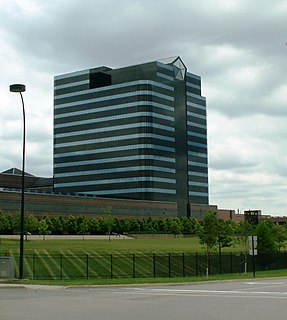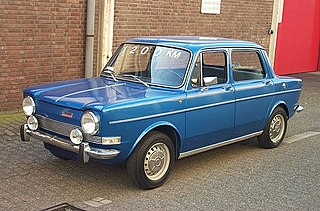
Chrysler is one of the "Big Three" automobile manufacturers in the United States, headquartered in Auburn Hills, Michigan. In addition to the Chrysler brand, Stellantis North America sells vehicles worldwide under the Dodge, Jeep, and Ram nameplates. It also includes Mopar, its automotive parts and accessories division, and SRT, its performance automobile division.
Dodge is an American brand of automobiles and a division of Stellantis, based in Auburn Hills, Michigan. Dodge vehicles currently include performance cars, though for much of its existence Dodge was Chrysler's mid-priced brand above Plymouth.

Simca was a French automaker, founded in November 1934 by Fiat and directed from July 1935 to May 1963 by Italian Henri Pigozzi. Simca was affiliated with Fiat and, after Simca bought Ford's French activities, became increasingly controlled by the Chrysler Group. In 1970, Simca became a subsidiary and brand of Chrysler Europe, ending its period as an independent company. Simca disappeared in 1978, when Chrysler divested its European operations to another French automaker, PSA Peugeot Citroën. PSA replaced the Simca brand with Talbot after a short period when some models were badged as Simca-Talbots.

Plymouth was a brand of automobiles produced by Chrysler Corporation and its successor DaimlerChrysler. The brand was launched in 1928 to compete in what was then described as the "low-priced" market segment that was dominated by Chevrolet and Ford. It became the high-volume seller for the automaker until the late 1990s. Plymouth cars were marketed primarily in the United States. The brand was withdrawn from the marketplace in 2001. The Plymouth models that were produced up to then were either discontinued or rebranded as Chrysler or Dodge.

FCA Canada Inc., formerly Chrysler Canada, is the wholly owned subsidiary of Stellantis through its North American division operating in Canada. Incorporated in 1925, the 'Chrysler Corporation of Canada' gained complete control of a Maxwell-Chalmers plant in Windsor, Ontario that had been used to manufacture some Chrysler models in the previous year. Initially called Chrysler Canada, Ltd, the name of the company changed to DaimlerChrysler Canada Inc following the merger of the two parent companies. In August 2007, the company was renamed Chrysler Canada Incorporated when Cerberus Capital Management purchased 80.1% of its parent company Chrysler LLC.

The Plymouth Reliant and Dodge Aries were introduced for model year 1981 as the first "K-cars" manufactured and marketed by the Chrysler Corporation. The Reliant was available as a 2-door coupe, 4-door sedan, or as a 4-door station wagon, in three different trim lines: base, Custom and SE. Station wagons came only in Custom or SE trim. Unlike many small cars, the K-cars retained the traditional 6 passenger 2 bench seat with column shifter seating arrangement favored by many Americans. The Reliant was powered by a then-new 2.2 L I4 SOHC engine, with a Mitsubishi "Silent Shaft" 2.6 L as an option. Initial sales were brisk, with the both Reliant and Aries each selling over 150,000 units in 1981. As rebadged variants, the Reliant and Aries were manufactured in Newark, Delaware, Detroit, Michigan, and Toluca, Mexico — in a single generation. After their introduction, the Reliant and Aries were marketed as the "Reliant K" and "Aries K".

The Hillman Avenger is a rear-wheel drive small family car originally manufactured by the former Rootes division of Chrysler Europe from 1970–1978, badged from 1976 onward as the Chrysler Avenger. Between 1979 and 1981 it was manufactured by PSA Peugeot Citroën and badged as the Talbot Avenger. The Avenger was marketed in North America as the Plymouth Cricket.

The Mitsubishi Galant is an automobile which was produced by Japanese manufacturer Mitsubishi from 1969 to 2012. The model name was derived from the French word galant, meaning "chivalrous". There have been nine distinct generations with total cumulative sales exceeding five million units. It began as a compact sedan, but over the course of its life evolved into a mid-size car. Initial production was based in Japan, but from 1994 the American market was served by vehicles assembled at the former Diamond-Star Motors (DSM) facility in Normal, Illinois.

The Chrysler Valiant was a full-size car which was sold by Chrysler Australia between 1962 and 1981. Initially a rebadged locally assembled Plymouth Valiant from the United States, from the second generation launched in 1963, the Valiant was fully manufactured in Australia. It was sold locally but also in New Zealand and South Africa, with smaller numbers also exported to South-East Asia and the United Kingdom.

Chrysler Europe was the American automotive company Chrysler's operations in Europe from 1967 through 1979. It was formed from the merger of the French Simca, British Rootes and Spanish Barreiros companies. In 1979, Chrysler divested these operations to PSA Peugeot Citroën.

TorqueFlite is the trademarked name of Chrysler Corporation's automatic transmissions, starting with the three-speed unit introduced late in the 1956 model year as a successor to Chrysler's two-speed PowerFlite. In the 1990s, the TorqueFlite name was dropped in favor of alphanumeric designations, although the latest ZF-based transmissions with the eight-speed automatic has revived the name.

Lists of automobile-related articles cover a wide range of topics related to cars. The lists are organized by manufacturer, region, sport, technology and so on.

The Mitsubishi Triton is a compact pickup truck produced by Mitsubishi Motors. In Japan it was originally known as the Mitsubishi Forte and from 1991 as the Strada. In the United States Chrysler Corporation sold captive imports as the Dodge Ram 50 and Plymouth Arrow truck, and Mitsubishi marketed it as the Mitsubishi Mighty Max until 2002.

The Chrysler 180 was the base name for a series of large saloon cars produced by Chrysler Europe. Resulting from joining development efforts of Rootes Group and Simca, the car was produced from 1970 to 1975 in Poissy, France, and later in Chrysler's subsidiary Barreiros' factory in Spain. The Chrysler 180 was also the base for the medium-sized model built by Chrysler Australia, the Chrysler Centura.

The Simca Vedette is a large car, manufactured from 1954 to 1961 by the French automaker Simca, at their factory in Poissy, France. The Vedette competed in France's large car market at a time when the economy was finally returning to growth, and enjoyed moderate success with its American style finished off by the Italian designer Rapi. It was marketed with different model names according to trim and equipment levels. The Vedette was Simca's largest model at that time and it spawned a more economical version, the Simca Ariane.

The Simca Aronde is an automobile which was manufactured by the French automaker Simca from 1951 to 1963. It was Simca's first original design, as well as the company's first unibody car. "/ Aronde -hirondelle" means "swallow" in Old French and it was chosen as the name for the model because Simca's logo at that time was a stylized swallow.

The Chrysler Centura is a midsize car which was produced by Chrysler Australia between 1975 and 1978. It was based on Chrysler Europe's Chrysler 180 model, but was also available with larger Australian-made Hemi Six engines. 19,770 Centuras were built.

The Dodge Journey is a mid-size crossover SUV which was manufactured and marketed by FCA's Dodge brand from model year 2009 to 2020, with a facelift for the 2011 model year. It was slotted below the larger Dodge Durango. With styling by Ryan Nagode, the Journey is marketed globally in both left and right hand drive. In many markets, the crossover has been marketed as the Fiat Freemont.

Chrysler, a large automobile manufacturer, was founded in the 1920s and continues today under the name Stellantis North America. The history of Chrysler involves engineering innovations, high finance, wide alternations of profits and losses, various mergers and acquisitions, and multinationalization.

A coupé utility is a vehicle with a passenger compartment at the front and an integrated cargo tray at the rear, with the front of the cargo bed doubling as the rear of the passenger compartment.

























